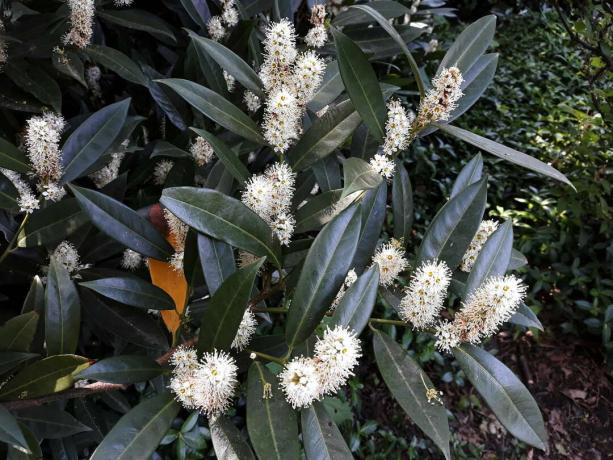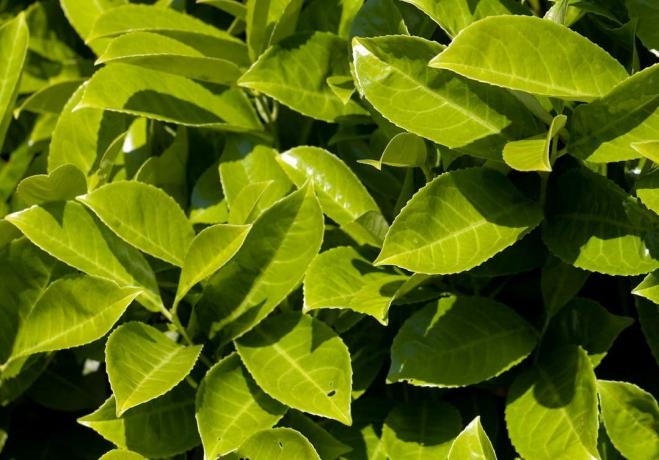We have compiled the reasons why your cherry laurel has brown or yellow leaves - as well as tips on how to avoid them.

cherry laurels (Prunus laurocerasus) impress all year round with their light to dark green leaves, which also offer pleasant privacy in winter. But this lush green splendor of leaves only shows up when the cherry laurel is healthy and feels good.
If the plant suffers from an illness, if it is stressed or undersupplied, this has a direct effect on the evergreen sea of leaves. The leaves then turn yellowish or brownish. The causes of this are just as varied as the ways to avoid the unsightly discolouration. Prevention is therefore always the best measure.
Causes of brown and yellow leaves on cherry laurel
- If the leaves of the otherwise evergreen cherry laurel turn yellow or even brown, this can be due to a variety of reasons. Whether it is incorrect care or a disease - we provide information about the ten most common causes of yellow and brown leaves on cherry laurel.
- The cherry laurel is considered to be extremely site-tolerant, but waterlogging should be avoided at all costs. This can occur when the soil is compacted and there is insufficient aeration. Yellow leaves usually appear quite early after planting due to site-related waterlogging.
- Also a too sunny location combined with insufficient water supply can lead to yellow leaves. Sunburn then occurs, causing the leaves to turn yellow irregularly. Young plants that have been raised in the greenhouse are particularly at risk. They are not yet used to the intense sunlight. Additional dangers lurk in winter. In the case of frost, the leaves of entire sections of the branch usually turn yellow.
- Regardless of whether Drought stress or too much water when there is sandy soil, both of which can eventually lead to yellow leaves. The problem with this is that the symptoms only become apparent later, sometimes even when the water supply is working properly again.
- Even fungal infections can lead to yellow leaves. The shotgun or leaf spot disease caused by the fungus Stigmina carpophila, leads to yellow marbled leaves with holes. The ones by the fungus Monilinia laxa Triggered shoot and tip drought in turn leads to yellow, wilted leaves.

- If the nutrient supply is not correct, the green coloring of the leaves will also decrease. If there is a lack of nitrogen, the entire leaf – including the leaf vein – turns yellowish. In the case of an iron deficiency, on the other hand, the leaf turns yellow down to the leaf veins.
- A relocation when transplanting or planting is pure stress for plants and unfortunately can also lead to yellow leaves.
- Although the cherry laurel is also in terms of the soil pH very tolerant, but too high a lime content in the soil inevitably leads to chlorosis (i.e. to a discoloration due to chlorophyll deficiency) as certain nutrients are no longer absorbed be able.
- If the cherry laurel is fertilized again too late in the year with a high nitrogen content, the newly formed shoots can no longer lignify until winter and are therefore very susceptible to frost damage, which are expressed in the leaves turning brown.
- Once or twice a year should Sliced cherry laurelwill. If the wrong time is chosen or if the leaves are injured, this also leads to an unsightly brown discoloration.
- If you ask your cherry laurel for a pot culture you need to make sure you have enough space, because the plants grow quickly and have deep roots. If the space in the bucket is too sparse, the leaves will slowly but surely turn yellow.
Bow brown and yellow leaves on cherry laurel
With some of these causes, it is enough to simply cut off the yellow leaves and give the cherry laurel time to recover. But other reasons call for targeted countermeasures. The numbers listed below refer to the causes mentioned above.
- If the soil is heavily compacted, the plant is dug up and half of the soil is loosened with sand. Otherwise it is sufficient to loosen the soil in the root area with a fork. But always be very careful not to damage the roots.
- You should water the plant sufficiently as soon as the soil dries out on the surface. This not only applies to summer, but also to winter. Therefore, water in winter on frost-free days and shade young solitary plants with fleece.
- Water the plant deeply when the top layer of soil has dried. Avoid waterlogging by laying out a drainage layer when planting and loosening the soil well.

- If you notice diseased regions, you should immediately remove them down to the healthy wood. Dispose of the plant material in the household waste and not on the compost, otherwise you will spread the infection throughout the garden. Young plants should be additionally treated with a fungicide. In the case of older plants, however, it is sufficient to spray with a more environmentally friendly sulfur preparation.
- In the event of deficiency symptoms, fertilize with a readily available fertilizer such as our Plantura Organic room and green plant fertilizer. You should also adjust the annual fertilization. If you only fertilized once a year before, you should switch to fertilizing twice. Also check the soil pH and adjust it down if necessary. This alone can lead to your cherry laurel being able to absorb enough iron again.
- After a move, you can only wait until the root system has established itself and the yellow leaves have grown back.
- So that the lime can be better washed out of the ground, the earth is loosened and sand is mixed in. If this does not help, the entire soil must be replaced. Mulching with acidic coniferous compost also helps to lower the soil pH again.
- In June at the latest, fertilize for the last time. In late summer you should only fertilize with potassium to make your cherry laurel less sensitive to frost.
- Pruning takes place before new shoots appear in February or immediately after flowering. To avoid unsightly brown edges, you should also use hand scissors instead of electric ones.
- If the bucket is too small for your cherry laurel, there is only one thing that will help: repot it into a larger bucket.

Precaution is therefore still the best measure against yellow and brown leaves. Therefore, we have everything for you in special articles about the right one Cherry laurel care and to the ideal Site selection for the cherry laurel collected.
